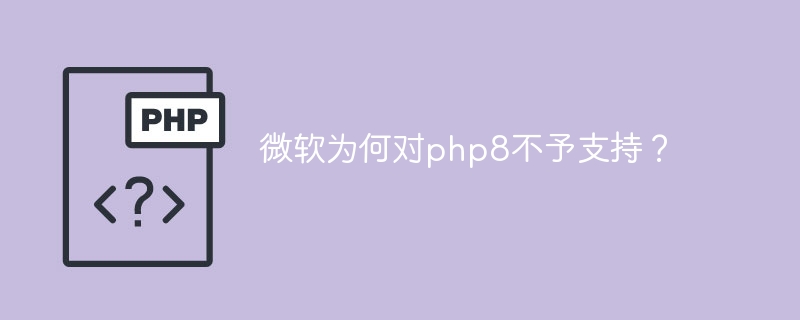Why doesn't Microsoft support php8?

Why does Microsoft not support PHP8?
PHP is a widely used open source server scripting language used to develop dynamic web pages and applications. Since its release in 1995, PHP has gone through multiple versions of updates and improvements, and PHP8, as the latest version, has greatly improved functionality and performance. However, although PHP8 has been widely recognized and adopted, Microsoft announced that it will not support PHP8, causing some controversy and confusion in the industry.
First, we need to understand why companies choose to support or not support a certain technology. For Microsoft, deciding whether to support a certain technology is mainly based on the following considerations:
- Market demand: Microsoft is a market-oriented company, and their products and services need to meet the needs of the majority of users. needs of user groups. If PHP8 is not in high demand in the market or Microsoft believes that the market is more interested in other programming languages, then they may choose not to support PHP8 to avoid investing resources and efforts.
- Compatibility and Integration: Microsoft's ecosystem is very broad and complex, with its own development tools and frameworks, such as ASP.NET and Azure. Microsoft will prioritize supporting technologies that are compatible and integrated with its ecosystem to provide a better user experience and seamless integration. If PHP8 is incompatible or difficult to integrate with Microsoft's ecosystem, Microsoft may not support it.
- Security and stability: Microsoft is a company that pays attention to security and stability, and they will carefully consider whether to support a technology. If Microsoft believes that PHP8 has security vulnerabilities or stability issues, they may choose not to support it to protect the security of users and systems.
The above are some of the main reasons that may cause Microsoft to not support PHP8. However, we cannot take this as an absolute. Microsoft is a nimble company and they will adapt based on market and user needs. If PHP8 becomes more common and popular in the future, and is better integrated and compatible with the Microsoft ecosystem, Microsoft may reconsider and provide support for PHP8.
For those developers and users who rely on PHP8, they may need to find other solutions on their own, or try to use third-party tools and frameworks to achieve integration with the Microsoft ecosystem. At the same time, they can also actively participate in the open source community, provide feedback and needs to Microsoft, and increase Microsoft's attention and support for PHP8.
In short, Microsoft's decision not to support PHP8 is based on a variety of considerations, such as market demand, compatibility and integration, security and stability, etc. However, as technology develops and user needs change, Microsoft may adjust its decisions based on actual conditions. For those developers and users who need to use PHP8, they can find other solutions or actively participate in the open source community to promote Microsoft's support for PHP8.
The above is the detailed content of Why doesn't Microsoft support php8?. For more information, please follow other related articles on the PHP Chinese website!

Hot AI Tools

Undress AI Tool
Undress images for free

Undresser.AI Undress
AI-powered app for creating realistic nude photos

AI Clothes Remover
Online AI tool for removing clothes from photos.

Clothoff.io
AI clothes remover

Video Face Swap
Swap faces in any video effortlessly with our completely free AI face swap tool!

Hot Article

Hot Tools

Notepad++7.3.1
Easy-to-use and free code editor

SublimeText3 Chinese version
Chinese version, very easy to use

Zend Studio 13.0.1
Powerful PHP integrated development environment

Dreamweaver CS6
Visual web development tools

SublimeText3 Mac version
God-level code editing software (SublimeText3)





